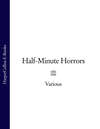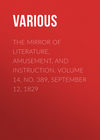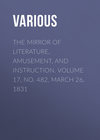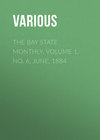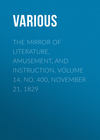Czytaj książkę: «The Mirror of Literature, Amusement, and Instruction. Volume 12, No. 337, October 25, 1828», strona 3
The Forget-Me-Not
MANNERS & CUSTOMS OF ALL NATIONS
(For the Mirror.)
SELLING MEAT AMONG THE ANCIENT ROMANS, &c
It was the custom for the buyer to shut his eyes, and the seller to hold up some of his fingers; if the buyer guessed aright, how many it was the other held up, he was to fix the price; if he mistook, the seller was to fix it. These classic blind-bargains would not suit the Londonbutchers. This custom was abolished by Apronius, the prefect of Rome; who in lieu thereof, introduced the method of selling by weight. Among the ancient Romans there were three kinds of established butchers, viz. two colleges or companies, composed each of a certain number of citizens, whose office was to furnish the city with the necessary cattle, and to take care of preparing and vending their flesh. One of these communities was at first confined to the providing of hogs, whence they were called suarii; and the other two were charged with cattle, especially oxen, whence they were called pecuarii, or boarii. Under each of these was a subordinate class, whose office was to kill, prepare, &c. called lanii, and sometimes carnifices.
Two English poets (Swift and Gay) have been rather severe towards the London butchers, the former says,—
"Hence he learnt the Butcher's guile,
How to cut your throat, and smile;
Like a butcher doom'd for life,
In his mouth to wear his knife."
The latter,—
——"resign the way,
To shun the surly butcher's greasy tray:
Butchers, whose hands are died with blood's foul stain,
And always foremost in the hangman's train."
The butchers' company was not incorporated until the 3rd year of King James I. when they were made a Corporation, by the name of master, wardens and commonalty of the art and mystery of butchers; yet the fraternity is ancient.
Stowe says, "In the 3rd of Richard II. motion was made that no butcher should kill any flesh within London, but at Knightsbridge, or such like distant place from the walls of the citie."
P.T.W
STUMBLING AT THE THRESHOLD
The phrase, "to stumble at the threshold," originated in the circumstance, that the old thresholds, or steps under the door, were like the hearths, raised a little, so that a person might stumble over them, unless proper care were taken. A very whimsical reason for this practice is given in a curious little tract by Sir Balthazar Gerbier, entitled, "Council and Advice to all Builders," 1663, in these words:—"A good surveyor shuns also the ordering of doores with stumbling thresholds, though our forefathers affected them, perchance to perpetuate the antient custome of bridegroomes, when formerly at their return from church they did use to lift up their bride, and to knock her head against that of the doore, for a remembrance that she was not to pass the threshold of her house without leave."
W.G.C
CHINESE PHYSICIANS
The charitable dispensation of medicines by the Chinese, is well deserving notice. They have a stone which is ten cubits high, erected in the public squares of their cities; whereon is engraved the name of all sorts of medicines, with the price of each, and when the poor stand in need of relief from physic, they go to the treasury to receive the price each medicine is rated at.
The physicians of China have only to feel the arm of their patient in three places, and to observe the rate of the pulse, to form an opinion on the cause, nature, danger, and duration of the malady. Without the patient speaking at all, they can tell infallibly what part is attacked with disease, whether the brain, the heart, the liver, the lungs, the intestines, the stomach, the flesh, the bones, and so on. As they are both physicians and apothecaries, and prepare their own medicines, they are paid only when they effect a cure. If the same rule were introduced with us, I fear we should have fewer physicians.
THE TOPOGRAPHER
BOX HILL
(For the Mirror.)
This celebrated eminence is situated in the north range of chalk hills, beginning near Farnham, in Surrey, and extending from thence to Folkstone, in Kent. Camden calls it White Hill, from its chalky soil; but Box Hill is its true and ancient name. The box-tree is, in all probability, the natural produce of the soil; but a generally received story is, that the box was planted there by Thomas, Earl of Arundel, between two and three centuries ago. There is, however, authentic evidence of its being here long before his time, for Henry de Buxeto (i.e. Henry of Box Hill) and Adam de Buxeto were witnesses to deeds in the reign of King John.
John Evelyn, who wrote about the middle of the seventeenth century, says, "Box-trees rise naturally at Kent in Bexley; and in Surrey, giving name to Box Hill. He that in winter should behold some of our highest hills in Surrey, clad with whole woods of them, might easily fancy himself transported into some new or enchanted country."
In Aubrey's posthumous work on Surrey, published in 1718, the northern part of the hill is described as thickly covered with yew-trees, and the southern part with "thick boscages of box-trees," which "yielded a convenient privacy for lovers, who frequently meet here, so that it is an English Daphne." He also tells us that the gentry often resorted here from Ebbesham (Epsom), then in high fashion. Philip Luckombe, in his "England's Gazetteer," says, on Box Hill "there is a large warren, but no houses; only arbours cut out in the box-wood on the top of the hill, where are sold refreshments of all sorts, for the ladies and gentlemen who come hither to divert themselves in its labyrinths; for which reason a certain author has thought fit to call it the Palace of Venus, and the Temple of Nature; there being an enchanting prospect from it of a fine country, which is scarce to be equalled for affording so surprising and magnificent an idea both of earth and sky."
But these delightful retreats, like Arcadia of old, have long since vanished. The yews were cut down in the year 1780; and their successors fall very short of the luxuriant descriptions of old topographers. The box has also at various times produced the proprietors of the estate great profit. In 1608, the receipt for box-trees cut down upon the sheepwalk on the hill was 50l.; in an account taken in 1712, it is supposed that as much had been cut down, within a few years before, as amounted to 3,000l.; and in 1759, a Mr. Miller lamented that "the trees on Box Hill had been pretty much destroyed; though many remained of considerable bigness."
An immense quantity of box is annually consumed in this country, in the revived art of engraving on wood. The English is esteemed inferior to that which comes from the Levant; and the American box is said to be preferable to ours. But the ships from the Levant brought such quantities of it in ballast, that the wood on Box Hill could not find a purchaser, and not having been cut for sixty-five years, was growing cankered. The war diminished the influx from the Mediterranean; several purchasers offered; and in 1795 it was put up to auction at 12,000l. The depredations made on Box Hill, in consequence of this sale, did not injure its picturesque beauty, as twelve years were allowed for cutting, which gave each portion a reasonable time to renew. In 1802, forty tons were cut, but the market being overstocked, it fell in value more than fifty per cent.; and the foreign wood is now universally preferred for engravings. The trees on Box Hill are, however, again flourishing, although their value is rather problematical.
For the information of the home tourist, perhaps, I ought to mention that Box Hill stands about 22 miles on the left of the road from London to Worthing, Brighton, and Bognor, and about 2 miles N.E. of the town of Dorking. The road from Leatherhead hence is a constant succession of hill and dale, richly clothed with wood, interspersed with elegant villas in all tastes—from the pillared and plastered mansion, to the borrowed charm of the cottage orne. The whole of this district is called the Vale of Norbury, from the romantic domain of that name, which extends over a great portion of the hills on the right of the road. Shortly before you reach Box Hill, stands Mickleham, a little village with an ivy-mantled church, rich in Saxon architecture and other antiquities. You then descend into a valley, passing some delightful meadow scenery, and the showy mansion of Sir Lucas Pepys, which rises from a flourishing plantation on the left. In the valley stands Juniper Hall, late the seat of Mr. Thomas Broadwood, the piano-forte manufacturer. In the park are some of the finest cedars in England. On again ascending, you catch a fine view of Box Hill, and the amphitheatrical range of opposite hills, with one of the most magnificent parterres in nature. This is called, by old writers, the Garden of Surrey.
You pass some flint-built cottages, and quitting the road here, the ascent to Box Hill is gradual and untiring, across a field of little slopes, studded with a few yew-trees, relics of by-gone days. The ascent further down the road almost amounts to a feat, assisted by the foot-worn paces in the chalky steep. Here this portion of the hill resembles an immense wall of viretum, down whose side has been poured liquid mortar. The path winds along the verge of the hill, whilst on the left is a valley or little ravine, whose sides are clothed with thick dwarfish box, intermingled with the wild and trackless luxuriance of forest scenery. Hence the road stretches away to Ashurst, the neat residence of Mr. Strahan, the King's printer.
Returning to the verge of the hill, you soon reach the apex, or highest point, being 445 feet from the level of the Mole.1 Here you enjoy what the French call a coup d'oeil, or I would rather say, a bird's-eye view, of unparalleled beauty. Taking the town of Dorking for a resting point, the long belt is about twelve miles in extent. The outline or boundary commences from the eminence on which I am supposed to be standing—with Brockham Hill, whose steep was planted by the late duke of Norfolk, and whence the chain extends away towards the great Brighton road. Next in the curve are Betchworth Castle and Park, with majestic avenues of limes and elms, and fine old chestnut-trees. Adjoining, is the Deepdene, the classical seat of the author of "Anastasius," a place, says Salmon, "well calculated for the religious rites of the Celts," and consecrated by the philosophical pursuits of the Hon. Charles Howard, who built an oratory and laboratory, and died here in 1714. Next are several fir-crowned ridges, which shelter Bury Hill, the mansion of Mr. Barclay, the opulent brewer; whence you ascend the opposite line of hills, till you reach Denbies, nearly facing the most prominent point of Box Hill. This elegant seat is the abode of Mr. Denison, one of the county members, and brother of the Marchioness of Conyngham. The second range or ledge, beneath Denbies, is the celebrated Dorking lime-works. The transition to the Norbury Hills, already mentioned, is now very short, which completes the outline of the view. It should, however, be remarked that the scenery within this range can be distinctly enjoyed without the aid of art; whilst beyond it the prospect extends, and fades away in the South Downs on one hand, and beyond the metropolis on the other.
The little parterre to be described, includes the sheltered town of Dorking, environed with rich lawny slopes, variegated with villas in the last taste; and little heights, from whose clustering foliage peeps the cottage roof of humble life. But the Paradise immediately at the foot of Box Hill is the gem of the whole scene, and is one of the most perfect pictures of rural beauty which pen or pencil can attempt. It appears like an assemblage of every rural charm in a few acres, in whose disposal nature has done much, and art but little. Park, lawn, woody walk, slope, wilderness and dell are among its varieties; and its quiet is only broken by the sluggish stream of the Mole. Adjoining is a little inn, more like one of the picturesque auberges of the continent than an English house of cheer. The grounds are ornamented with rustic alcoves, boscages, and a bowery walk, all in good taste. Here hundreds of tourists pass a portion of "the season," as in a "loop-hole of retreat." In the front of the inn, however, the stream of life glides fast; and a little past it, the road crosses the Mole by Burford Bridge, and winds with geometrical accuracy through the whole of this hasty sketch.
PHILO
Here is a stump of wood which denotes the grave of Major Labelliere, a deranged officer of the Marines, who, by his own request was buried on this spot, with his head downwards; it being a constant assertion with him, "that the world was turned topsy-turvy, and, therefore, at the end he should be right."
From this point may be seen Leith Hill, with an old prospect tower, within which are interred the remains of another eccentric gentleman who died in the neighbourhood. In the road from Dorking thence is Wotton, the family seat of the Evelyns.











